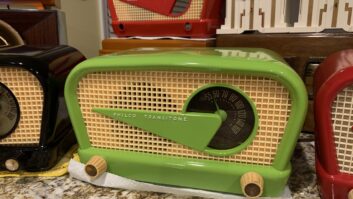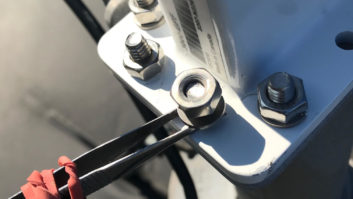Quality FM tuners suitable for both broadcast and professional use are nearly as extinct as full-time engineers. Equally scarce are the high-performance consumer products of the 1970s – McIntosh, Accuphase, Sansui and Harman-Kardon to mention a few – that were adaptable for more critical applications.
(click thumbnail)These tuners were remarkably sensitive and often had sufficient audio finesse to serve as air monitors.
There remains a demand for high-end receivers for recording purposes and for translator use that provide accurate air monitoring by the management of multistation operations.
One such product is the Fanfare FT-1A, an FM tuner/monitor.
Evaluation PhilosophyEach station seems to have developed its own tonal signature, some magnificent and others horrific. Flat response in many instances has become a fudge factor for proof of performance tests.
Judging requires an FM tuner that is neutral, doesn’t add its own colorations and is perhaps more accurate than the outputs of some modulation monitors themselves.
Then how does one judge the audio worthiness of a tuner?
I am dead-set against testing a tuner with only a signal generator because it does not reflect the real world. My first question to someone who believes in this method is, “Did you add two SCAs, RDS and a little multpath to your generator?”
My evaluation of the Fanfare pitted it against 10 domestic tuners on hand, with particular attention paid to an A/B comparison with a 1977-vintage Kenwood 600-T.
This particular tuner has an eight-gang tuning capacitor, three separate IF strips for each bandwidth (only the super-narrow has been modified), stereo that is second to none, a highly accurate, fast-acting modulation meter and mono and stereo sensitivity that always shouts “winner.”
Its performance parameters have been verified carefully using two Motorola 2002R signal generator/monitors and a Sencore SG-80 generator.
– Don Scott
Fanfare fills the void
The FT-1A has several professional broadcast features, including three sets of audio outputs, both low- and high-level RCA unbalanced audio jacks and balanced XLR connectors.
On the back panel is a BNC connector with an associated level control for composite output. This provides direct connection to translator exciters, modulation monitors or other off-air measuring devices. A fused IEC power connector also is included.
As on many FM receivers, storing a preset is achieved by tuning the desired station and holding in one of the eight selected presets until the word “set” appears in the aqua blue display.
Manual tuning speed increases in 500-kHz increments after holding Manual Tune Control up or down for a few seconds. The auto-scan threshold stops only for stations exhibiting 50 dB quieting or better. The quickest method to tune in a new station, if it is below the 50 dB quieting level, is to select Scan, let the tuner get close to the desired station and then touch the Tune Up or Down to fine-tune the station.
Two IF bandwidths and a five-segment signal meter are provided. The remote control included duplicates front-panel functions.
Under the hood
The circuitry in the FT-1A is basic technology: It uses a four-gang front end, three ceramic IF filters, quadrature detector, conventional stereo decoding, and surface-mount techniques.
Most circuit traces are small, which aid the tuner in rejection of out-of-band signals and extraneous noises. The low-level RCA audio outputs are capacitor-coupled; the high-level and balanced audio connections are direct-coupled.
A buffer stage isolates the composite output from the IF strip. The enclosure and parts are of good quality and the unit has a three-year limited warranty.
The tuner features a sliding high-blend circuit to lessen stereo noise. The purpose of a high-blend circuit is to diminish weak-signal stereo noise and still preserve as much stereo separation as possible. Blend is adjustable by an internal potentiometer.
The quirk with the Fanfare’s blend circuit is that when it is set to affect noise on weaker stations, it rolls off treble response in both stereo and mono.
If a station is too weak to be listened to in stereo, a push of the mono button should bring relief, not muffled highs.
I understand why this is done in automotive environments. In a car, the absence of noise generally is preferable to the ultimate preservation of fidelity. However, in professional use, precise preservation is preferred.
In addition, the car-radio style blend is a gradual blend toward mono as signal strength decreases. I have found that moderate signals, or those slightly less than optimum, can be noisy as well due to on-channel interference, requiring a fixed mild blend to take the edge off the slight noise present, regardless of signal strength. A sliding blend (as used by Fanfare), dictated by signal strength, does not address these noisy situations.
On the positive side, it is possible under the right conditions – slightly weak signals that have constant signal strength – the internal blend in the FT-1A can be adjusted to effectively reduce noise without losing too much stereo or high-frequency content.
Back seat or front seat?
Creative station engineers often employ a spouse’s car radio as an impartial monitor to check a station’s audio quality. So, maybe there is some merit to Fanfare designing a 110-V product using similar circuitry?
To answer that question, here are the results of testing these important parameters: sensitivity, adjacent-channel selectivity, capture ratio, SCA suppression and overall sound quality.
Sensitivity: Mono 30 dB quieting occurs slightly above the specified 10.5 dBf/0.92 uV at 11.10 dBf/0.98 uV, still a fairly good figure. In stereo, the manufacturer claims 11.50 dBf/1.03 uV for 30 dB quieting. (Ed note:Fanfare prefers the term “useable sensitivity,” which it has determined to be between 20 and 30 dB.
The overall evaluation is that the tuner is 10 percent shy of its sensitivity claims, but this is not a serious problem unless all out sensitivity is needed, for instance, in a translator application.
Adjacent-channel selectivity is the most critical parameter in any tuner due to the thousands of signals in North America. If a weak station needs to be received clearly next to a much stronger signal, adjacent-channel selectivity in the order of 40 dB accompanied by low distortion is needed, otherwise splatter will occur. The Fanfare claim of 25 dB was nearly met at 102.1 MHz vs.102.3 MHz.
Tuning each side of these frequencies, adjacent-channel selectivity dropped to a low of 10 dB at 88.3 MHz vs. 88.5 MHz and was at about 15 dB at the upper end of the dial. Note the Fanfare does have adequate selectivity for most applications.
Capture Ratio is an important characteristic, especially when on-channel interference is a problem. The manufacturer’s claim of 1.5 dB was correct in wide and only slightly less in narrow, satisfactory and typical of a quality tuner. From what I understand, a capture ratio of 1.5 dB means it takes +94.38 percent, or nearly twice the desired signal, to obtain 30 dB down of the lesser signal.
A capture ratio of 2 dB would require +200.35 percent, or nearly three times the original signal for the 30 dB down as a capture ratio of 1 dB. Going the other direction, a capture ratio of 0.05 dB would be three times as good as a capture ratio of 1 dB.
Rarely, is it possible to build a high-gain, narrow-band tuner and still obtain a better capture ratio than that of the Fanfare, and I encountered no unusual problems with the tuner rejecting on-channel stations. In comparison, the reference Kenwood unit’s capture ratio is 0.08 dB in wide, 1 dB in normal and 1.70 dB in narrow.
SCA Suppression: The -70 dB figure claimed was met. There was only slight birdie residue from RDS artifacts on classical stations with low, masking modulation.
I listened to this tuner through all three of its audio outputs and was not thrilled by the audio quality of what I heard from the low- and high-level outputs because, while fairly clean, dynamic punch was not revealed.
I happened to catch some Irish folk music, filled with lots of foot-stomping dynamics, on Vassar College radio station WVKR(FM) in Poughkeepsie, N.Y. I switched quickly between all three audio outputs: the balanced outputs running through a quality 600 ohm to 75 k-ohm matching transformer and all three outputs feed into an upgraded B&K Pro-Five preamp.
Bingo – prominent on the balanced outputs, the punch was there along with deeper bass and less murky treble, matching the reference Kenwood in this respect.
In another instance, I caught some reggae on WNTI(FM) in Hackettstown, N.J., and got the same results. Consequently, I recommend using the balanced outputs where possible. Stereo separation specs of 40 dB and careful listening verified that stereo separation was nearly at what is obtainable, as long as the provisions under the blend discussion in this article were met.
Alone in the field
There are few competitors that offer both balanced audio and composite outputs as standard features. The Fanfare can blow its trumpets at being the lowest-priced at $1,495. Factory options available for the FT-1A include AMAX AM stereo, RS-232 data I/O, Carrier Sense and control lockdown.
A typical setup for broadcasters might be the Inovonics tunable 530 FM modulation monitor/receiver at $2,500, advertised as a broadband receiver not intended for high adjacent-channel selectivity.
Climbing higher is the Magnum Dynalab MD-108 at $5,850, although the company does offer composite output as an option on its other tuners priced from $1,600 upward. Another upper-end domestic tuner to consider would be the Accuphase T-109V, at about $3,800.
On the low end of the stick is the Rolls RS79 AM/FM tuner with balanced audio for $380, which can serve as a utility tuner. If a tuner is needed without the added features of balanced audio or composite outputs, the Sim Audio “Moon” tuner at $2,695 has outstanding performance.
With all things considered, the Fanfare offers good performance/dollar value.
For more information contact Fanfare Electronics in New York at (716) 683-5451, fax (716) 683-5421 or visit the company Web site at www.fanfare.com.













